Alberto Savinio’s Life and Work on Television: Programs by the Italian Public Broadcaster RAI Between the Late Seventies and Early Eighties
Chiara Mari Chiara Mari Alberto Savinio, Issue 2, July 2019https://italianmodernart-new.kudos.nyc/journal/issues/alberto-savinio/
The late seventies were an important time for the critical reappraisal of Alberto Savinio’s work and its disclosure to a wider, non-specialist audience. The Italian public broadcaster Rai closely followed this rediscovery from the start, documenting it in its cultural programs. At the same time, Rai offered its own narration of Savinio’s life and work, thanks to original research by its authors. This paper investigates the ways in which Rai addressed Savinio’s life and work in its broadcasts, with a particular focus on the docudrama Alberto Savinio, il polipragmon (1978). Directed by Anna Zanoli, this docudrama is the first TV biography of Savinio and a significant example of a wider reflection on the possibilities of ‘translating’ a body of work or an artist’s biography for the small screen.
In the late seventies, the Italian public broadcaster Radiotelevisione italiana (RAI) played a significant role in the critical reappraisal of Alberto Savinio’s work and its exposure to a wider, general audience.1 At the beginning of the decade, an article by Salvatore Battaglia2 marked fresh interest in Savinio’s writings, which until then had been mostly misunderstood and ignored by critics.3 In 1973, the first monograph on Savinio, by Ugo Piscopo, offered a thorough account of both the character of the writer and of his work,4 and it was followed by significant comprehensive studies, among them Walter Pedullà’s Alberto Savinio. Scrittore ipocrita e privo di scopo (Alberto Savinio: A hypocritical and aimless writer, 1978). In December 1979, Radiocorriere, the weekly magazine of the RAI, published a review of Pedullà’s book eloquently titled “Un caso di flagrante ingiustizia” (A case of flagrant injustice).5 The article also considered recent television programs dedicated to Savinio and therefore the RAI’s commitment to Savinio’s rather late rediscovery (figure 1).

The republication of Savinio’s major literary works and other writings in the seventies accompanied renewed interest in his theatrical works, beginning with a restaging of his one-act opera Orfeo vedovo (Orpheus the widower, 1950) at the Piccola Scala in Milan in 1974.6 Around this time, research into his music7 (figure 2), as well as highly regarded retrospective exhibitions organized in Milan in 1976, at the Palazzo Reale,8 and Rome in 1978, at the Palazzo delle Esposizioni,9 provided the foundation for a mature historicization of Savinio’s efforts as well as for an all-around analysis of his creative path.
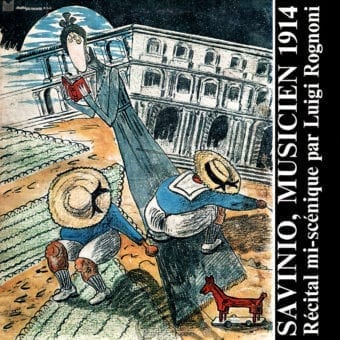
The course of this path included his significant contributions to radio as an artistic medium,10 notably his collaboration with the RAI on pioneering radio dramas (Agenzia Fix, 1949;11 Cristoforo Colombo, 1951)12 among other programs.13 Meanwhile, Italian television was closely documenting the critical rediscovery of Savinio, sponsoring original research and producing cultural programs that narrated his life and work. In the RAI archives, the first significant presence of Savinio on the small screen dates to 1969, when an exhibition of his drawings at the Il Segno gallery in Rome inspired an episode of the program L’Approdo (“The landing,” in the nautical sense) on the growing interest in his visual work. The L’Approdo episode mentioned the tribute to Savinio’s paintings curated by Enrico Crispolti as part of the exhibition Alternative attuali 3 (Present-day alternatives 3) held in 1968 in L’Aquila, and revolved around two interviews, with his wife, Maria Savinio, and the poet Giuseppe Ungaretti respectively, which, unfortunately, can only be seen in fragments today, at the RAI archives.14
By the second half of the seventies, as in-depth reinterpretation of Savinio’s work continued to develop, television was taking a broader look at his output, and the RAI was following the revival of his theatrical works with particular interest. In 1978, for example, a short clip of Arnaldo Picchi’s staging of the play Capitano Ulisse (Captain Ulysses; written in 1925, published in 1934, and first performed 1938) was shown on an episode of the RAI program Teatromusica.15 In 1983, the program Prisma devoted considerable attention to Emma B. Vedova Giocasta (Emma B. Widow Giocasta, 1949), directed by Egisto Marcucci with the title role masterfully interpreted by the actress Valeria Moriconi.16 The rapid overview offered here of the presence of Savinio’s work on television serves to introduce and contextualize the focus of this essay: namely the docudrama Alberto Savinio, o polipragmon (Alberto Savinio, the versatile man, 1978).
But first it is interesting to pause briefly to examine a program broadcast in August 1976, Un’opera… un viaggio… un sogno (A work… a travel… a dream…), a detailed monograph on the performance La partenza dell’argonauta (The Argonaut leaving, 1976). Adapted from Savinio’s story of the same name (published in Hermaphrodito, 1918), the play was staged at the Teatro della Pergola in Florence in June 1976, during the Maggio Musicale Fiorentino festival, and it marked the first theatrical representation of Savinio’s narrative work.17 The hour-long broadcast interspersed parts of the play with interviews with the director Memé Perlini, the stage designer Antonello Aglioti, and the musical composer Marcello Panni. The show brought to the stage the journey in 1917 of the Argonaut Savinio from Italy to Greece, projecting it into the present. Perlini explained that he had actually “squatted” in a “train compartment through central Italy” and had reinterpreted “Savinio’s worries and aspirations,” “jumping from his time”18 to the present of the seventies (figure 3). Italian television promptly recorded the significant rediscovery of the theatricalism inherent in some of Savinio’s stories and novels, which furthered the work of reinterpreting and regenerating the texts then being done at the forefront of theater and music research.19 This and other programs were more than mere documentaries; they should be recognized as tiny pieces in the mosaic of the circulation and remediation of Savinio’s iconographies and texts.
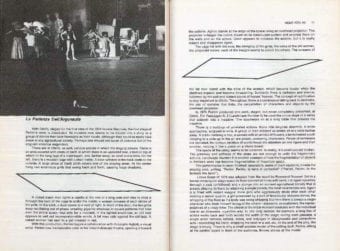
Anna Zanoli, a well-known figure of Italian cultural television, played a major role in this “televised history” of Savinio and in the drafting of his audio-visual biography. After graduating in the humanities and writing an art history thesis, Zanoli joined the RAI in 1960. Over the course of her career there, she contributed much to the dissemination of culture.20 In 1977, she began work on Alberto Savinio, o polipragmon (Alberto Savinio, the versatile man), her first television biography.21 As both the director and screenwriter of the film, she faced with a number of obstacles due to a lack of funding, but nevertheless managed to complete the production, and in 1978 Alberto Savinio, o polipragmon was entered in the prestigious international competition Prix Italia.
Simultaneously, Zanoli produced a documentary on the great retrospective exhibition of Savinio’s work on view at the Palazzo delle Esposizioni in Rome, as the pilot episode of what was to become the very successful program Grandi Mostre (Great Exhibitions). Broadcast on July 1, 1978,22 the episode was an opportunity to research and fine-tune the narrative procedures also being developed for the docudrama (figure 4). As an introduction to Savinio, it alternated passages of evocative, poetic writing – typical of Zanoli’s style – with plainer, more informative tones of voice. It gave an overview of the exhibited works and documents and included interviews with curators Daniela Fonti and Pia Vivarelli, along with footage of Palma Bucarelli – the memorable former director of the Galleria Nazionale d’Arte Moderna, and an icon of the art world in Rome – speaking about Savinio the portraitist while standing in front of his portrait of her.
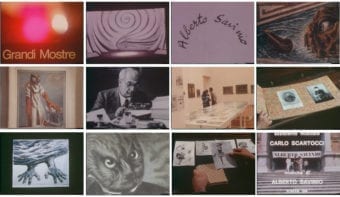
Savinio’s rediscovery, as documented by this program, is the opening theme of the docudrama Alberto Savinio, o polipragmon – that is, of the versatile man, as Savinio liked to call himself. The film was first broadcast on June 6, 1979.23 Its beginning is cleverly set in the present, the seventies, when a young traveler gets off a train at the Paris station of Gare de L’Est and finds recent editions of Tragedia dell’infanzia (Tragedy of childhood, 1937; republished in 1975), Hermaphrodito (Hermaphrodite, 1918; republished in 1974), Il signor Dido (Mr. Dido, 1978), and Souvenirs (1945; then 1976) at a newsagent’s stall (figure 5). An offscreen voice reads a passage from Maupassant e “l’altro” (Maupassant and ‘the other,’ 1944; republished in 1975) on the “destino ferroviario” (railway destiny) of books by Guy de Maupassant and by Savinio himself, under the name of his character Nivasio Dolcemare. The offscreen voice says: “Who has seen for a long part of his literary career his books forced to inertia and the ridiculous modesty of exceptional milieu, knows what a deep satisfaction it is to see one day his books run on the fast and profitable wheels of the great publishing and to go up the shelves of the library carts of the stations.”24
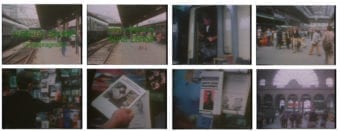
Zanoli’s unusual perspective immediately outlines a story, which is also a reflection of the present, about the new life of Savinio’s work. This perspective does not offer a linear narrative, but rather leaps between past and present with an implicit reflection, as in all of Zanoli’s work, on the television screen’s mediation of the work of art. This approach is visually represented in the first sequence as a shot of a mirror reflecting the portraits of Alberto Savinio and Giorgio de Chirico (figure 6). Savinio’s biography is reconstructed in detail through the incorporation of original documents and quotations from his works, drawing the spectator into his artistic world. For example, his arrival in Paris is narrated as follows: “Alberto Savinio arrived in Paris from Munich on the evening of February 25, 1910. The city was flooded, and it seemed to him almost a seaside town. Paris reappeared ‘little by little as the Neptunian city re-emerging from the sea. Only a light mist continued to hover over the domes and towers, over the expanse of shining roofs.’”25
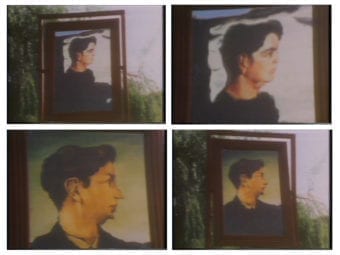
From a black-and-white flooded Paris, recovered in the impressive images of a Pathé newsreel (figure 7) and recalled in a passage from La casa ispirata (The inspired house, 1925),26the dramatization returns to the present with shots of La Ruche, an artist’s residence in the Montparnasse district of Paris (figure 8).
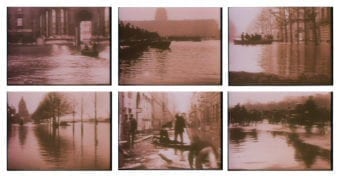
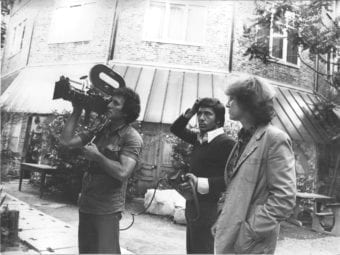
These images cue an introduction to the Parisian artistic climate at the time, and to the artists and writers whom Savinio met there. Guillaume Apollinaire, who published Savinio in his magazine Les soirées de Paris, hosted one of his famous concerts at the magazine’s offices in May 1914. This episode is staged by Zanoli in a very original way, with a set design inspired by the editorial office as described by Savinio in Casa “la Vita” (Home “the life,” 1943) as a sort of house of mirrors: “even the doors were covered in mirrors, and when they opened or shut, the light vibrated and lit up the rooms.”27 The concertgoers are represented by Zanoli as contoured, black-and-white photographs resting on trestles (figure 9), connecting with the central theme of memory in Savinio’s poetry, and of the recovery of a dimension of distance from something that belongs to the past but can be relived in different form in the present. In his stage notes for Vita dell’uomo (Life of man, 1951), Savinio envisaged the “silhouettes of the Mother and Father. Larger than life. In black and white” as stage presences. “The real characters,” he wrote, “are colored: they are the present. The Parents are the past, and the past is colorless.”28
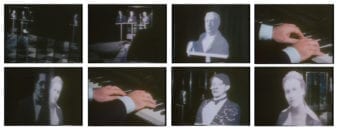
There follows an interview with Gabrielle Buffet, an art critic and musicologist who was Francis Picabia’s wife, and ninety-six years old at the time of the interview (figure 10). Her testimonial, which recalls with amused irony the famous concert held in Paris in 1914, offers an understanding of the various levels of research Zanoli’s film compiles:
Yes, I have very nice memories about Savinio the musician. He was a great friend of Apollinaire. Apollinaire admired him a lot and absolutely wanted me to make his acquaintance. He said, “You must hear him! He is extraordinary. He plays and every time he plays, he breaks a piano string.” […] Savinio was waiting for us and the room was prepared [for the concert]. He was a handsome man, charming and very nice. Since Savinio had theorized a new music, there was a lot of curiosity about this concert. Well, he started to play some very impressive music, a genre that they called Italian and that is a somewhat pejorative way of defining in France everything that is magniloquent and highly contrasted. Then at once, and here Apollinaire began to show signs of great satisfaction, there was a little noise, like a whistle: a string of the piano jumped. Apollinaire gave me a look as if to say, “Here, you heard, I warned you!”29
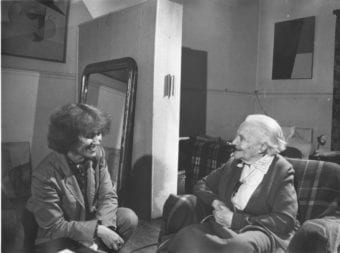
Also notable in the docudrama are staged sequences adapted from “Le chants de la mi-mort” (Songs of the half-dead), Savinio’s dramatic poem published in French in Les soirées de Paris in 1914 that features the metaphysical mannequin and, in embryonic form, the first intuition of a possible encounter between music, painting, and writing. The final part of the “Chants” was translated for the first time into Italian by Zanoli30 and staged by actors of Giancarlo Nanni’s Fabbrica dell’Attore, including Manuela Kusterman, a key figure of the experimental theater scene that had been flourishing in Rome since the mid-sixties. Even if only as a brief fragment deliberately recited as though for a theatrical rehearsal, here was an update of Savinio’s theater. It was an attempt to come to terms with a very difficult text, put forward by Zanoli due to its importance in Savinio’s body of work (figure 11).
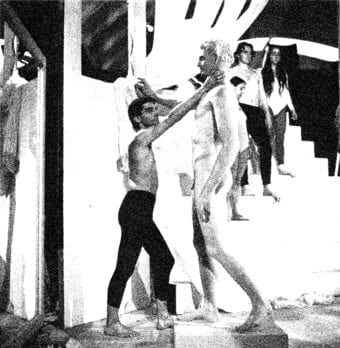
While it is not possible to analyze the entire film in the space of this essay, these brief sequences demonstrate how Anna Zanoli followed an alternative route from the traditional documentary form: she created a dramatized biography, staged with inventive images, often in place of verbal commentary.
As is well known, Savinio wrote many articles on cinema. He reflected on the possibility of a dialogue between cinema and other arts, and several times stressed how it was “an error to consider” film an instrument to “reproduce reality precisely.”31 Savinio recognised that cinema provided an opportunity not only to document an artist’s work or biography, as he himself had done in collaboration with film director Carlo Malatesta for a 1943 documentary on Andrea Mantegna, but also to create true “pictorial dramas,” created through the combination of various images.32 Although Savinio’s commentaries on cinema would be collected and published by Mario Verdone and Giovanni Scheiwiller only in 1981, Zanoli stressed on several occasions that in creating her television biography she had been mindful of the fact that Savinio denied that his work gave reality any superficial support. He expressed this position in writings such as “La verità sull’ultimo viaggio” (The truth about his last journey, 1934), which proposes the idea of the theater as “a colored adventure” free from the criteria of plausibility (figure 12).33
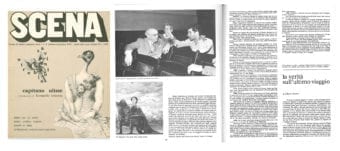
Zanoli turned her research on Savinio’s work – and on the places he lived, and the thoughts and recollections of Gabrielle Buffet, the film critic and writer Nino Franck, and the publisher Valentino Bompiani – into an imagistic tale intended as a personal interpretation of Savinio’s polymorphism and visionary imagination. In a statement published on the occasion of a 1980 Savinio retrospective in Ferrara, at which Alberto Savinio, o polipragmon was shown, Zanoli defined the docudrama as a tale told “through symbols, visions, and significant inventions” (figures 13–17):
I have used the images in anything but an impersonal way. I have used the images and musical comment to narrate and to be critical. I have personified the paintings of bird-headed women by using masks on the actresses. I have turned his literary descriptions of his childhood in Greece into moving images. […] I have left the rich Levantine stretched out on the sofa drinking coffee and the girl playing the piano on rafts drifting on the sea to accentuate the feeling of disorientation among the survivors of the fire in Thessaloniki, captured by Savinio using his typical way of arranging objects in his paintings on wooden platforms.34
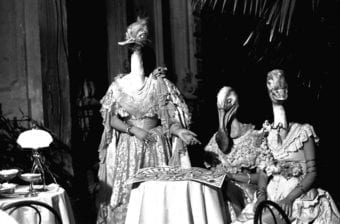
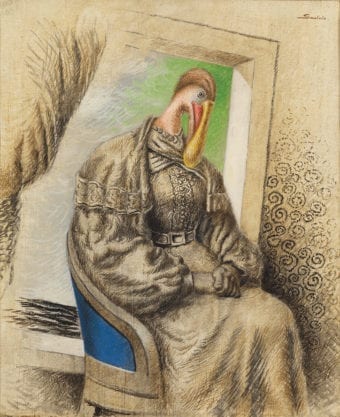
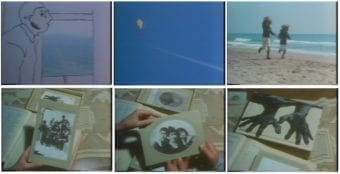
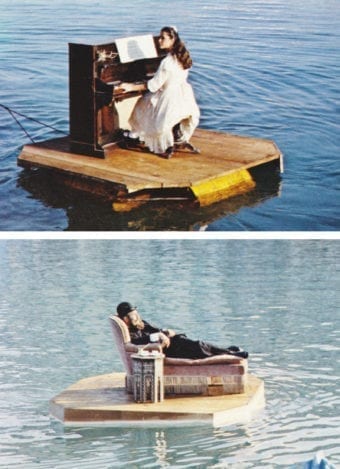
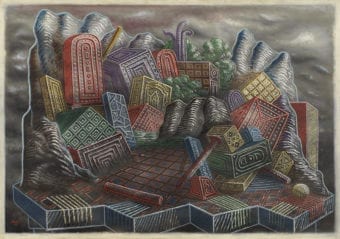
Zanoli allowed the images to reach maximum evocative power through imaginative directorial decisions, from the choice of settings to costumes designed by Vera Marzot (figures 18–19), renowned for her collaborations with Luchino Visconti and Vittorio De Sica. Zanoli’s research resulted in a profound reflection not only on the possibilities, but also on the limits of television in presenting works of art on the small screen. It led, for example, to the choice of showing the paintings in the final sequence not fastened to the walls of a museum, but “moving” between the hands of workers dismantling an exhibition in Rome in 1978.
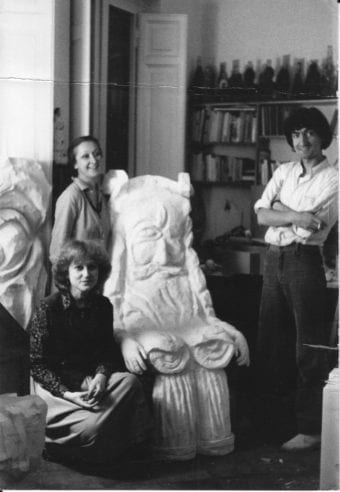
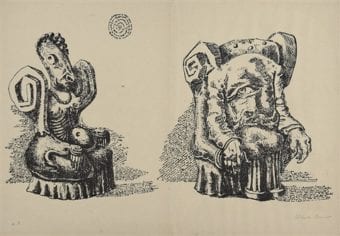
In Alberto Savinio, o polipragmon, the difference between reality and staging, the contamination and compresence of different codes of communication, and the highlighting and irony of mechanisms of make-believe are procedures for interpreting Savinio’s poetry. At the same time, they can be likened to aspects of the postmodern narrative, to which Savinio’s work was a precursor beyond any critical or stylistic label. Indeed, it is not by chance that it is possible nowadays to approach Savinio’s work through a postmodern lens that allows for new interpretations of his narrative and theatrical oeuvre.
Bibliography
Alberto Savinio. Rome: De Luca, 1978. Exhibition catalogue.
Bartolucci, Giuseppe, and Memé Perlini. “Intervista-riflessione (attorno al ‘viaggio’ da Savinio a noi).” In XXXIX Maggio Musicale Fiorentino. Florence: Ente Autonomo del Teatro Comunale, 1976, 341–44.
Bartolucci, Giuseppe, and Donatella Rimoldi. Immagine – Immaginario. Il lavoro del Teatro La Maschera di Memé Perlini e Antonello Aglioti. Turin: Studio Forma, 1978.
Battaglia, Salvatore. “Savinio e il surrealismo civico.” Il dramma 46, no. 2 (February 1970): 39–44.
Bolla, Luisella, and Flaminia Cardini. Le Avventure dell’arte in TV: quarant’anni di esperienze italiane. Turin: Nuova ERI, 1994.
Cigliana, Simona. “Un caso di flagrante ingiustizia.” Radiocorriere 56, no. 52 (December 23–29, 1979): 96.
Di Sacco, Paolo. “Rassegna di studi saviniani.” Ariel 10, nos.1–2 (January–August 1995): 259–85.
Fagiolo dell’Arco, Maurizio. Alberto Savinio. Milan: Fabbri Editori, 1989.
Falqui, Enrico. “I ‘Dialoghi’ di Luciano rivissuti da Savinio.” Radiocorriere 31, no. 28 (July 11–17, 1954): 12.
“I dialoghi di Luciano.” Radiocorriere 28, no. 49 (December 2–8, 1951): 13.
Magnani, Sergio. “Agenzia Fix.” Radiocorriere 27, no. 13 (April 9–13, 1950): 9.
Mari, Chiara. “L’opera d’arte nello ‘specchio’ televisivo: la trasmissione Vidikon di Anna Zanoli.” LUK, no. 23 (January–December 2017): 39–53.
Mele, Rino. “The Theatre of Memé Perlini.” The Drama Review 22, no. 1 (March 1978): 63–72.
Pedullà, Walter. Alberto Savinio. Scrittore ipocrita e privo di scopo. Cosenza: Lerici, 1979.
Pinottini, Marzio, Ruggero Savinio, and Pia Vivarelli, eds. Alberto Savinio. Milan: Electa, 1976. Exhibition catalogue.
Piscopo, Ugo. Alberto Savinio. Milan: Mursia, 1973.
Porzio, Michele. Savinio musicista. Il suono metafisico. Venice: Marsilio, 1988.
Pugliese, Sergio. “Festival radiofonico.” Radiocorriere 26, no. 52 (December 25–31, 1949): 17–19.
Rognoni, Luigi. “Perché Savinio musicien 1914.” In Savinio, musicien 1914, edited by Luigi Rognoni. Milan: Multhipla Records, 1976.
Savinio, Alberto. La casa ispirata. Milan: Adelphi, 1986.
Savinio, Alberto. Casa “La Vita.” 4th ed. Milan: Bompiani, 1971.
Savinio, Alberto. Hermaphrodito. Turin: Einaudi, 1974.
Savinio, Alberto. Il sogno meccanico, edited by Vanni Scheiwiller. Milan: Quaderni della Fondazione Primo Conti – Libri Scheiwiller, 1981.
Savinio, Alberto. “La verità dell’ultimo viaggio.” Scena 1, no. 5 (October–November 1976): 43–47.
Savinio, Alberto. Maupassant e “l’altro.” Milan: Adelphi, 1975.
Tinterri, Alessandro. Savinio e lo spettacolo. Bologna: il Mulino, 1993.
Tutone, Sabina. “Il ‘progress’ scenico delle pièces saviniane (tra incomprensioni dei primi debutti e la recente ‘riabilitazione’).” Ariel 10, 1–2 (January–August 1995): 209–34.
Valentino, Luca. L’arte impura: percorsi e tematiche del teatro di Alberto Savinio. Rome: Bulzoni, 1991.
Vivarelli, Pia. Alberto Savinio: catalogo generale. Milan: Electa, 1996.
V. V. “Il Cristoforo Colombo.” Radiocorriere 29, no. 41 (October 5–11, 1952): 12.
Zanoli, Anna. “Alberto Savinio il prolipragmon.” In Comune di Ferrara, Sala polivalente, Parco Massari: programma, ottobre/dicembre 1980. Ferrara: s.n., 1980: 4–5.
Zanoli, Anna. “Io e … Pasolini e la forma della città. Memoria e ricerca intorno a una trasmissione televisiva.” Paragone 62, third series, no. 95 (January 2011): 8–44.
Zanoli, Anna. “Io e … Zavattini e il Campo di grano con corvi di Van Gogh.” In “A tutti i pittori ho chiesto l’autoritratto.” Zavattini e i Maestri del Novecento, edited by Marina Gargiulo, 34–37. Milan: Skira, 2013. Exhibition catalogue.
How to cite
Chiara Mari, “Alberto Savinio’s Life and Work on Television: Programs by the Italian Public Broadcaster RAI Between the Late Seventies and Early Eighties,” in Alberto Savinio, monographic issue of Italian Modern Art, 2 (July 2019), https://www.italianmodernart.org/journal/articles/alberto-savinios-life-and-work-on-television-programs-by-the-italian-public-broadcaster-rai-between-the-late-seventies-and-early-eighties/, accessed [insert date].
- I wish to thank Anna Zanoli for her invaluable help and generosity in allowing me to access the documents in her archive. I would like to additionally thank Sabina Tutone for her advice and fruitful exchange of ideas, and Vincenzo Magagna.
- Salvatore Battaglia, “Savinio e il surrealismo civico,” Il dramma 46, no. 2 (February 1970): 39–44; republished as the introduction to Alberto Savinio, Torre di guardia, ed. Leonardo Sciascia (Palermo: Sellerio, 1977).
- On the reception of Savinio by critics, see Paolo Di Sacco, “Rassegna di studi saviniani,” Ariel 10, nos. 1–2 (January–August 1995): 259–85.
- Ugo Piscopo, Alberto Savinio (Milan: Mursia, 1973).
- Simona Cigliana, “Un caso di flagrante ingiustizia,” Radiocorriere 56, no. 52 (December 23–29, 1979): 96.
- The text and music of Orfeo vedovo are by Alberto Savinio. The production was staged at Piccola Scala on December 16, 1974, with orchestra direction by Ettore Gracis, direction by Filippo Crivelli, and set design by Tito Varisco.
- For example, Savinio, musicien 1914, ed. Luigi Rognoni (Milan: Multhipla Records, 1976).
- The catalogue of the Palazzo Reale exhibition, Alberto Savinio (Milan: Electa, 1976), includes texts by Raffaele Carrieri, Franco Russoli, Sergio Zoppi, Marzio Pinottini, Luigi Rognoni.
- The catalogue of the Palazzo delle Esposizioni exhibition, Alberto Savinio (Rome: De Luca, 1978), includes texts by Maurizio Fagiolo, Daniela Fonti, and Pia Vivarelli.
- See Alessandro Tinterri, Savinio e lo spettacolo (Bologna: il Mulino, 1993), 190–202.
- Agenzia Fix was first broadcast on April 15, 1950, at 22:05 p.m. Rete Rossa, Compagnia di Prosa di Roma (Prose Company of Rome) of the Italian Public Radio, with the actor Arnoldo Foà and the Symphony Orchestra and Chorus of Rome of the Italian Public Radio, directed by Carlo Maria Giulini and Anton Giulio Majano. The radio drama was broadcast in the Festival di opere radiofoniche in prima esecuzione (Festival of first-run radio dramas). Cf. Sergio Pugliese, “Festival radiofonico,” Radiocorriere 26, no. 52 (December 25–31, 1949): 17–19; Sergio Magnani, “Agenzia Fix,” Radiocorriere 27, no. 13 (April 9–13, 1950): 9.
- Cristoforo Colombo was first broadcast on October 8, 1952, at 21:15 p.m. Terzo Programma, Compagnia di Prosa di Roma of the Italian Public Radio, directed by Anton Giulio Majano. Cf. V. V., “Il Cristoforo Colombo,” Radiocorriere 29, no. 41 (October 5–11, 1952): 12.
- For example, Dialoghi e romanzetti di Luciano di Samosata, adaptation and musical score by Alberto Savinio, Compagnia di prosa di Firenze (Prose Company of Florence) of the Italian Public Radio-Television, directed by Corrado Pavolini, broadcast from December 6, 1951, Terzo Programma, 21:00 p.m. Cf. “I dialoghi di Luciano,” Radiocorriere 28, no. 49 (December 2–8, 1951): 13; Enrico Falqui, “I ‘Dialoghi’ di Luciano rivissuti da Savinio,” Radiocorriere 31, no. 28 (July 11–17, 1954): 12. On Savinio’s musical works, see Michele Porzio, Savinio musicista. Il suono metafisico (Venice: Marsilio, 1988).
- “Un pittore letterato: Alberto Savinio,” broadcast on March 18, 1969, on channel 2 television as part of the program L’Approdo. Settimanale di lettere e arti, curated by Antonio Barolini, Giorgio Ponti, and Franco Simongini, with the collaboration of Geno Pampaloni, Roberto M. Cimnaghi, and Walter Pedullà, and directed by Siro Marcellini.
- Teatromusica. Settimanale di notizie dello spettacolo, curated by Claudio Rispoli with the collaboration of Roberto Leydi. Service entitled Dei ed eroi a Firenze, broadcast in 1978 on channel 2 television (the service is undated in the Teche RAI archives).
- Prisma. Settimanale di varietà e di spettacolo del TG1, curated by Gianni Raviele, broadcast in 1983 on channel 1 television (the service is undated in the Teche RAI archives). Also broadcast in 1983 was the television drama Vita di Nivasio Dolcemare, curated by Lucia Restivo and directed by Guido Maria Compagnoni (channel 3 television, December 10, 1983); it is less interesting, in my opinion, for our reflection here.
- The program was broadcast on August 6, 1976, on the channel 2 television RAI. While the RAI program has not yet been digitalized, it can be reconstructed via a broadcasting playlist accessible in the multimedia archives Teche RAI.
- Giuseppe Bartolucci and Memé Perlini, “Intervista-riflessione (attorno al “viaggio” da Savinio a noi),” in XXXIX Maggio Musicale Fiorentino (Florence: Ente Autonomo del Teatro Comunale, 1976), 342. On the theatrical work of Perlini, see Rino Mele, “The Theatre of Memé Perlini,” The Drama Review 22, no. 1 (March 1978): 63–72; Giuseppe Bartolucci and Donatella Rimoldi, Immagine – Immaginario. Il lavoro del Teatro La Maschera di Memé Perlini e Antonello Aglioti (Turin: Studio Forma, 1978).
- On this topic, see Sabina Tutone, “Il ‘progress’ scenico delle pièces saviniane (tra incomprensioni dei primi debutti e la recente ‘riabilitazione’),” Ariel 10, nos. 1–2 (January–August 1995): 209–34. On Savinio’s theater and its revival since the seventies, see also Luca Valentino, L’arte impura: percorsi e tematiche del teatro di Alberto Savinio (Rome: Bulzoni, 1991); Alessandro Tinterri, Savinio e lo spettacolo (Bologna: il Mulino, 1993).
- On Anna Zanoli’s work for Italian public television, see Luisella Bolla and Flaminia Cardini, Le Avventure dell’arte in TV: quarant’anni di esperienze italiane (Turin: Nuova ERI, 1994), 170–82; Anna Zanoli, “Io e … Pasolini e la forma della città. Memoria e ricerca intorno a una trasmissione televisiva,” Paragone 62, no. 95 (January 2011): 8–44; Anna Zanoli, “Io e … Zavattini e il Campo di grano con corvi di Van Gogh,” in “A tutti i pittori ho chiesto l’autoritratto.” Zavattini e i Maestri del Novecento, ed. Marina Gargiulo, exh. cat. (Milan: Skira, 2013): 34–37; Chiara Mari, “L’opera d’arte nello ‘specchio’ televisivo: la trasmissione Vidikon di Anna Zanoli,” LUK, no. 23 (January–December 2017): 39–53.
- Alberto Savinio, o polipragmon. 16 mm film transferred to video. Direction and screenplay by Anna Zanoli, direction of photography by Giancarlo Ferrando, film editing by Lina Drovetti, costumes by Vera Marzot, and setting by Carlo Cagni. Rome: Raiuno, 1978.
- Channel 1 television RAI, 10:25 p.m.
- Channel 1 television RAI, 10 p.m.
- “Chi ha veduto per lunga parte della sua carriera letteraria i propri libri costretti all’inerzia e ai ridicoli pudori degli ambienti d’eccezione, sa quale profonda soddisfazione è invece vedere un giorno i propri libri correre sulle rapide e proficue ruote della grande editoria e salire le scansie dei carrelli bibliari delle stazioni” (in Alberto Savinio, Maupassant e “l’altro” (Milan: Adelphi, 1975), 35. Translated by Jennifer Knaeble).
- “Alberto Savinio arrivò a Parigi da Monaco di Baviera la sera del 25 febbraio 1910. La città era allagata e a lui sembrò quasi una città marina. Parigi riappariva ‘a poco a poco città nettuniana che va riemergendo dal mare. Solo una nebbia leggera continuava a librarsi sulle cupole e le torri, sulla distesa dei tetti lucenti.’” Alberto Savinio, o polipragmon. Translated by Jennifer Knaeble.
- Alberto Savinio, La casa ispirata (Milan: Adelphi, 1986): 121. Initially published by G. Carabba (Lanciano) in 1925.
- “[…] anche le porte erano rivestite di specchi, e quando i battenti si aprivano o si chiudevano, una vibrazione luminosa animava le sale.” Alberto Savinio, Casa “la Vita,” 4th ed. (Milan: Bompiani, 1971), 17.
- “In mezzo alla scena, le sagome del Padre e della Madre. Più grandi del vero. In bianco e nero. I personaggi reali sono colorati: sono il presente. I Genitori sono il passato, e il passato perde colore.” Quoted in Maurizio Fagiolo dell’Arco, Alberto Savinio (Milan: Fabbri Editori, 1989), 20.
- “Sì, ho dei ricordi molto piacevoli su Savinio musicista. Era un grandissimo amico di Apollinaire. Apollinaire lo ammirava molto e voleva assolutamente che io facessi la sua conoscenza. Diceva: ‘Lo devi sentire è assolutamente straordinario. Lui suona e tutte le volte che suona rompe una corda del pianoforte’. […] Savinio ci aspettava e la sala era preparata. Lui era un bell’uomo, affascinante, simpaticissimo. E siccome Savinio teorizzava una nuova musica c’era molta curiosità per questo concerto. Bene, lui ha cominciato a suonare una musica molto d’effetto, un genere che chiamavano all’italiana e che è un modo un po’ peggiorativo di definire in Francia tutto quello che è magniloquente, molto contrastato. Poi in una volta, e qui Apollinaire ha cominciato a dare segni di grande soddisfazione, si è sentito un piccolo rumorino, come un fischietto: era una corda del pianoforte che saltava. Apollinaire mi ha dato un’occhiata come per dire: ‘Ecco, hai sentito, ti avevo avvisata!’” Translated by Jennifer Knaeble.
- The original French version of the “Chants de la mi-mort” was republished in Alberto Savinio, Hermaphrodito (Turin: Einaudi, 1974).
- “Rivista del cinematografo I,” in Alberto Savinio, Il sogno meccanico, ed. Vanni Scheiwiller (Milan: Quaderni della Fondazione Primo Conti – Libri Scheiwiller, 1981), 67.
- Alessandro Tinterri, Savinio e lo spettacolo (Bologna: il Mulino, 1993), 110.
- Alberto Savinio’s “La verità dell’ultimo viaggio” was published in 1934 as an introduction to Capitano Ulisse in Quaderni di “Novissima;” it was republished in Scena 1, no. 5 (October–November 1976): 43–47.
- “Ho usato le immagini in modo tutt’altro che impersonale, ho usato le immagini e il commento musicale per narrare e fare critica. Ho personificato i dipinti con le donne ornitocefale per mezzo di attrici con maschere, ho trascritto in immagini in movimento le descrizioni letterarie dell’infanzia in Grecia. […] Ho depositato il ricco levantino che beve il caffè steso sul divano e la ragazza che suona il pianoforte, su zattere alla deriva nel mare, in modo da accentare il senso di spaesamento fra gli scampati all’incendio di Salonicco colto da Savinio usando un modo suo tipico di comporre gli oggetti, nei dipinti, su pedane di legno.” Anna Zanoli, “Alberto Savinio il prolipragmon,” in Comune di Ferrara, Sala polivalente, Parco Massari: programma, ottobre/dicembre 1980 (Ferrara: s.n., 1980), 4–5. Translated by Jennifer Knaeble.

